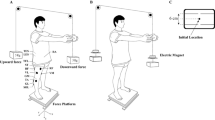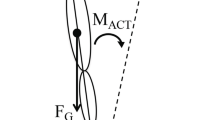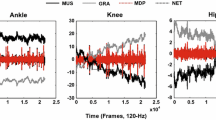Achievement of the behavioral aim of most motor acts requires coordination of posture and movement. We report here our studies of this coordination using body bending in the sagittal plane in standing humans as an example. These movements are particularly complex to study, as both components of the motor act (the main component, with the aim of producing a behavioral result, i.e., bending per se, and the “accessory” postural component, i.e., with the aim of maintaining balance during the movement) include movements of large body parts, which hinders the separation of these two components. These were discriminated on the basis of current views of the features of postural components as compared with those of the main target component. The main and postural components were shown to correspond to movements along the eigenvectors of the dynamic equation. These movements were unique, as they simultaneously demonstrated both “kinematic” and “dynamic” synergies, so they were termed “natural synergies.” The coordination of natural synergies in conditions of standing on wide and narrow supports was studied. The experimentally observed coordination was found to be close to the optimum coordination providing minimal movements of the center of pressure. This guarantees maintenance of the position of the center of pressure within the support area, as required to maintain balance.
Similar content being viewed by others
References
Aleksandrov, A. V. Frolov, A. A., and Massion, J., “Strategy maintaining balance on bending of the trunk on a narrow support in humans,” Ross. Zh. Biomekh., 6, 63–78 (2002).
Alexandrov, A. V. and Frolov, A. A., “Closed-loop and open-loop control of posture and movement during human upper trunk bending,” Biol. Cybern., 104, No. 6, 425–438 (2011).
Alexandrov, A. V., Frolov, A. A., and Massion, J., “Axial synergies during human upper trunk bending,” Exp. Brain Res., 118, 210–220 (1998).
Alexandrov, A. V., Frolov, A. A., and Massion, J., “Biomechanical analysis of movement strategies in human forward bending. I. Modeling,” Biol. Cybern., 84, 425–434 (2001a).
Alexandrov, A. V., Frolov, A. A., and Massion, J., “Biomechanical analysis of movement strategies in human forward bending. II. Experimental study,” Biol. Cybern., 84, 435–443 (2001b).
Alexandrov, A. V., Frolov, A. A., Horak, F. B., et al., “Feedback equilibrium control during human standing,” Biol. Cybern., 93, 309–322 (2005).
Allen, J. L. and Ting, L. H., “Why is neuromechanical modeling of balance and locomotion so hard?” in: Neuromechanical Modeling of Posture and Locomotion, Springer, New York (2016), pp. 197–223.
Babinski, J., “De l’asynergie cérébelleuse,” Rev. Neurol., 7, 806–816 (1899).
Bardy, B. G., Marin, L., Stoffregen, T. A., and Bootsma, R. J., “Postural coordination modes considered as emergent phenomena,” J. Exp. Psychol. Hum. Percept. Perform., 25, 1284–1301 (1999).
Barin, K., “Evaluation of a generalized model of human postural dynamics and control in the sagittal plane,” Biol. Cybern., 61, 37–50 (1989).
Belen’kii, V. E., Gurfinkel’, V. S., and Pal’tsev, E. I., “Elements in the control of voluntary movements,” Biofi zika, 12, 135–11 (1967).
Bernshtein, N. A., The Construction of Movements, Moscow (1947).
Bizzi, E., Kalil, R., and Tagliasco, V., “Eye-head coordination in monkeys: evidence for centrally patterned organization,” Science, 173, 452–454 (1971).
Bouisset, S. and Zattara, M., “A sequence of postural movements precedes voluntary movement,” Neurosci. Lett., 22, 263–270 (1981).
Bouisset, S. and Zattara, M., “Biomechanical study of the programming of anticipatory postural adjustments associated with voluntary movement,” J. Biomech., 20, 735–742 (1987).
Bouisset, S. and Zattara, M., “Anticipatory postural adjustments and dynamic asymmetry,” in: Stance and Motion: Facts and Concepts, Gurfinkel, V. S. et al. (eds.) (1988), pp. 177–183.
Bouisset, S. and Zattara, M., “Segmental movements as a perturbation to balance? Facts and concepts,” in: Multiple Muscle Systems: Biomechanics and Movement Organization, Winters, J. M. and Woo, S. L. (eds.), Springer, New York (1990), pp. 498–506.
Bouisset, S., Do, M. C., and Zattara, M., “Posturo-kinetic capacity assessed in paraplegics and parkinsonians,” in: Posture and Gait: Control Mechanisms, Woollacott, M. and Horak, F. (eds.), University of Oregon Press, Eugene (1992), Vol. II, pp. 19–22.
Brown, J. E. and Frank, J. S., “Influence of event anticipation on postural actions accompanying voluntary movement,” Exp. Brain Res., 67, 645–650 (1987).
Commissaris, D. A. C. M. and Toussaint, H. M., “Anticipatory postural adjustments in a bimanual, whole body lifting task with an object of known weight,” Hum. Mov. Sci., 16, 407–431 (1997).
Cordo, P. J. and Nashner, L. M., “Properties of postural adjustments associated with rapid arm movements,” J. Neurophysiol., 47, 287–302 (1982).
Feldman, A. G. and Levin, M. E., “The origin and use of positional frames of reference in motor control,” Behav. Brain Sci., 18, 723–806 (1995).
Friedly, W. G., Cohen, L., Hallett, M., et al., “Postural adjustments associated with rapid arm movements. II. Biomechanical analysis,” J. Neural Neurosurg. Psychiat., 51, 232–243 (1988).
Friedly, W. G., Hallett, M., and Simon, S. R., “Postural adjustments associated with rapid arm movements. I. Electromyographic data,” J. Neural Neurosurg. Psychiat., 51, 232–243 (1984).
Gel’fand, M. I. and Tsetlin, M. L., “Mathematical modeling of the mechanisms of the central nervous system,” in: Models of the Structural-Functional Organization of Various Biological Systems, Nauka, Moscow (1966).
Gurfinkel’, V. S., Kots, Ya. M., and Shik, M. L., Regulation of Posture in Humans, Nauka, Moscow (1965).
Gurfinkel, V. S., Lipshits, M. I., Mori, S., and Popov, K. E., “Stabilization of body position as the main aim of postural regulation,” Fiziol. Cheloveka, 7, 400–410 (1981).
Hess, W. R., “Teleokinetisches and erreismatisches Kraftesystem in der Biomotorik?” Helv. Physiol. Pharm. Acta, No. 1, C62–C63 (1943).
Hirschfeld, H. and Forssberg, H., “Phase-dependent modulation of postural activity patterns during human locomotion,” J. Neurophysiol., 63, 505–600 (1990).
Horak, F. B. and Macpherson, J. M., “Postural orientation and equilibrium,” in: Handbook on Integration of Motor Circulatory, Respiratory, and Meta bolic Control during Exercise, Towell, L. B. and Shepherd, J. T. (eds.), American Physiological Society, Bethesda (1996), pp. 255–292.
Horak, F. B. and Nashner, L. M., “Central programming of postural movements: adaptation to altered support-surface configurations,” J. Neurophysiol., 55, 1369–1381 (1986).
Horak, F. B., Henry, S. M., and Shamway-Cook, A., “Postural perturbations: new insights for treatment of balance disorders,” Phys. Ther., 77, 517–533 (1997).
Jung, R. and Hassler, R., “The extrapyramidal motor system,” in Handbook of Physiology (1960), No. 2, pp. 863–927.
Kuo, A. D. and Zajac, F. E., “A biomechanical analysis of muscle strength as a limiting factor in standing posture,” J. Biomech., 26, Suppl. 1, 137–150 (1993).
Kuypers, H. G. J. M., “Anatomy of the descending pathways,” in: Handbook of Physiology, Section 1, The Nervous System, V B Brooks (ed.), American Physiology Society, Bethesda (1981), Vol. II, Motor Control, Part 1, pp., 597–666.
Latash, M. L., Synergy, Oxford Univ. . Press (2008).
Latash, M., Control of Human Movement, Human Kinetics, Champaign, IL (1993).
Lee, W. A., Buchanan, T. S., and Rogers, M., “Effects of arm acceleration and behavioral conditions on organization of postural adjustments during arm flexion,” Exp. Brain Res., 66, 257–270 (1987).
Magnus, R., Der Korperstellung, Springer Verlag, Berlin (1924).
Massion, J., “Movement, posture and equilibrium: interaction and co-ordination,” Prog. Neurobiol., 38, 35–56 (1992).
Massion, J., “Postural control system,” Curr. Opin. Neurobiol., 4, 877–887 (1994).
Massion, J., “Postural control systems in developmental perspective,” Neurosci. Biobehav. Rev., 22, 465–472 (1998).
Massion, J., Alexandrov, A., and Frolov, A., “Why and how are posture and movement coordinated?” in: Progress in Brain Research: Brain Mechanisms for the Integration of Posture and Movement, Mori, S et al. (eds.), Elsevier, Amsterdam (2004), Vol. 143, pp. 13–27.
Nardone, A. and Schiepati, M., “Postural adjustments associated with voluntary contraction of leg muscles in standing man,” Exp. Brain Res., 69, 469–480 (1988).
Nashner, L. M. and Forssberg, H., “Phase-dependent organization of postural adjustments associated with arm movement while walking,” J. Neurophysiol., 55, 1382–1394 (1986).
Nashner, L. M. and McCollum, G., “The organization of human postural movements: a formal basis and experimental synthesis,” Behav. Brain Sci., 8, 135–172 (1985).
Nashner, L. M., “Fixed patterns of rapid postural responses among leg muscles during stance,” Exp. Brain Res., 30, 13–24 (1977).
Oddson, L. and Thorstensson, A., “Fast voluntary trunk flexion movements in standing: primary movements and associated postural adjustments,” Acta Physiol. Scand., 128, 341–349 (1986).
Prochazka, A., “Sensorimotor gain control: a basic strategy of motor systems?” Prog. Neurobiol, 33, 281–307 (1989).
Rademaker, G. G. J., Das Stehen: Statische Reactionen, Gleichwichtsreaktionen und Muskeltonus unter Besondere Berucksichtung Ihres Verhaltens bei Kleinhirnlosen Tieren, Springer Verlag, Berlin (1931).
Runge, C. F., Shupert, C. L., Horak, F. B., and Zajac, F. E., “Ankle and hip postural strategies defined by joint torques,” Gait Posture, 10, 161–170 (1999).
Runge, C. F., Shupert, C. L., Horak, F. B., and Zajac, F. E., “Role of vestibular information in initiation of rapid postural responses,” Exp. Brain Res., 122, 403–412 (1998).
Sherrington, C. S., The Integrative Action of the Nervous System, C. Scribner’s Sons, New York (1906).
Stapley, P., Pozzo, T., and Grishin, A., “The role of anticipatory postural adjustments during whole body forward reaching movements,” NeuroReport, 9, 1–7 (1998).
Suzuki, Y., Nomura, T., Casadio, M., and Morasso, P., “Intermittent control with ankle, hip, and mixed strategies during quiet standing: a theoretical proposal based on a double inverted pendulum model,” J. Theor. Biol., 310, 55–79 (2012).
Thomas, A., Equilibre et Equilibration, Masson, Paris (1940).
Torres-Oviedo, G. and Ting, L. H., “Muscle synergies characterizing human postural responses,” J. Neurophysiol., 98, No. 4, 2144–2156 (2007).
Toussaint, H. M., Commissaris, D. A., van Dieen, J. H., et al., “Controlling the ground reaction force during lifting,” J. Motor Behav., 27, 225–234 (1995).
Toussaint, H. M., Michies, Y. M., Faber, M. N., et al., “Scaling anticipatory postural adjustments dependent on confi dence of load estimation in a bi-manual whole body lifting task,” Exp. Brain Res., 120, 85–94 (1998).
Weiss P, “Self differentiation of basic patterns of coordination,” Comp. Psychol. Monogr., 17, 1–96 (1961).
Winter, D. A., Biomechanics and Motor Control in Human Movement, John Wiley and Sons, New York (1990), 2nd ed.
Yung, J. F., Winter, D. A., and Wells, R. P., “Postural dynamics in the standing human,” Biol. Cybern., 62, 309–320 (1990).
Zattara, M. and Bouisset, S., “Chronometric analysis of the posturo-kinetic programming of voluntary movement,” J. Motor Behav., 18, 215–223 (1986).
Author information
Authors and Affiliations
Corresponding author
Additional information
Translated from Zhurnal Vysshei Nervnoi Deyatel’nosti imeni I. P. Pavlova, Vol. 67, No. 1, pp. 33–48, January–February, 2017.
Rights and permissions
About this article
Cite this article
Aleksandrov, A.V., Frolov, A.A. Biomechanical Analysis of Posture and Movement Coordination in Standing Humans during Bending of the Trunk in the Sagittal Plane. Neurosci Behav Physi 48, 436–447 (2018). https://doi.org/10.1007/s11055-018-0584-6
Received:
Accepted:
Published:
Issue Date:
DOI: https://doi.org/10.1007/s11055-018-0584-6




